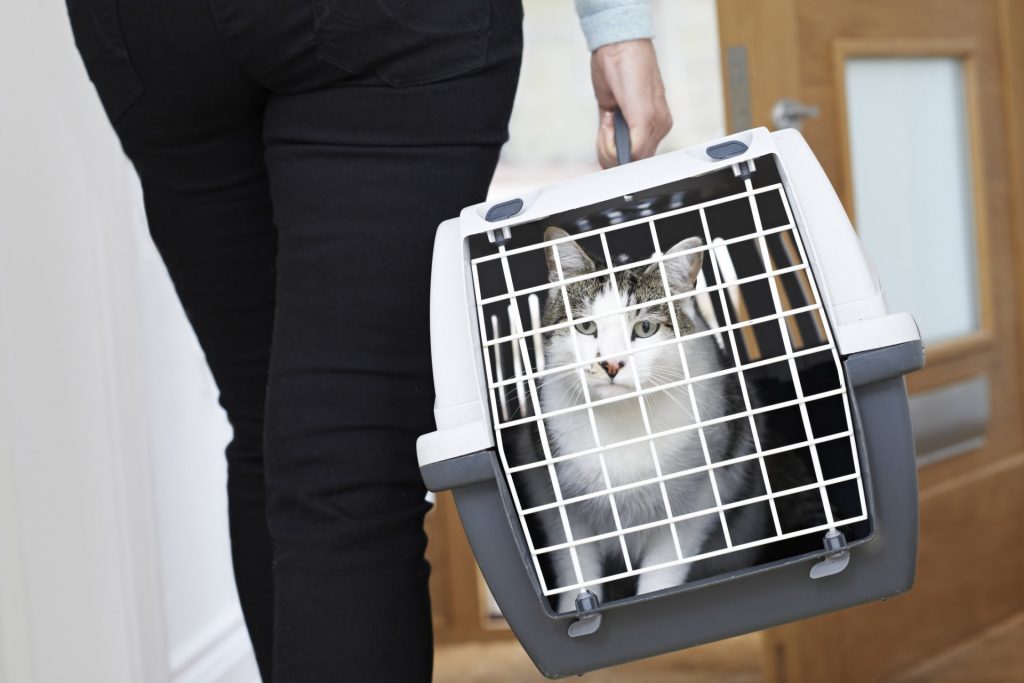We want to help make your pet’s travel time as fear-free as possible. This includes trips the vets, boarding facilities, moving house or anytime they leave home. For vet visits this ensures the patient arrives calm and does not enter the hospital already stressed and anxious. Follow these tips to ensure a peaceful ride!
- Your pet should voluntarily get into a cat carrier or seatbelt harness. It is preferable to do this before leaving the house so the cat or small dog is carried to the car and the larger dogs are walked to the car on lead.
- To get your cat used to a cat carrier, leave it in a commonly used area of the house at all times and incorporate some positive rewards into it’s use such as feeding the pet in it or placing toys for them to hide in it. You may also use treats or pheromones to make it even more appealing.
- Seatbelt harnesses can be introduced in a similar fashion. Use high reward treats to gradually introduce the harness so they do not fear it and in fact look forward to putting it on.
- When move the cat carrier try to minimise movement. For example supporting it with two hands or holding it from underneath feels much more stable to the cat compared to carrying it by the handle. This ensures they remain higher up and aren’t eye-to-eye with dogs when entering the vet hospital.
- Consider how to make your car a calm environment:
- Classical, calm music or an audiobook will help to keep your pet calm.
- Pheromones can be applied to a towel over the carrier or directly to your car seats 10-15 minutes prior to travel. Lavender oil is also calming and can be applied.
- Consider car temperature prior to putting your pet in e.g. run the airconditioning for a few moments prior to placing them in the car.
- Make sure your pet is in a non-slip environment in the car. For carriers the best place is on the floor behind a front seat or on a back seat secured by a seatbelt so no sliding occurs. For large dogs either the back seat or boot (if hatchback or SUV) is appropriate ensuring they have a seatbelt applied or are confined in some way (e.g. caged in boot or crate).
- Don’t rush. Your pet will sense you are stressed! We’d much prefer you to run a few minutes late and be safe and calm. Speak to your pet as you usually would.
- If your pet is prone to car sickness, ensure you brake, accelerate and take turns slowly.
- If your pet appears nauseas or overly anxious in the car consider prescription medications and speak to your vet about options.
Other tips specific to vet visits:
- Cats tend to need 5-10 minutes to adjust to a new environment so try to leave plenty of time for them to be placed in the cat chillax zone and further pheromones applied. Dogs may prefer to wait outside. If this is the case you can call reception and alert them to your arrival whilst you remain in the car or out the front. The vet can signal you once they are ready. Alternatively take a seat in the dog-only waiting room and apply a pheromone-sprayed bandanna to your dog’s neck to help reassure them.
- Hungry is good! This will make the treats provided by the vet staff more appealing! If your pet has specific preferences for treats, bring them!
- Feel free to bring familiar items your pet likes such as a toy or brush. This may help them relax whilst in the vet hospital.
- We can’t speak highly enough for pheromone therapy. Feliway is available in spray form and can be applied to towels, blankets, the car or a bandanna for your cat. Adaptil is available in a spray form or collar and can be applied in similar ways.
- Give your pet an opportunity to go to the toilet before arriving in the hospital. For dogs do this at home and again out the front of the hospital.



